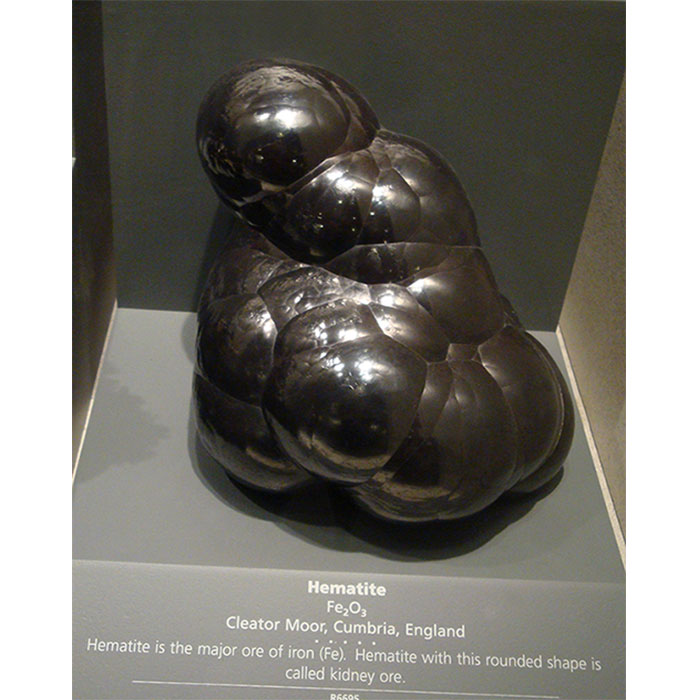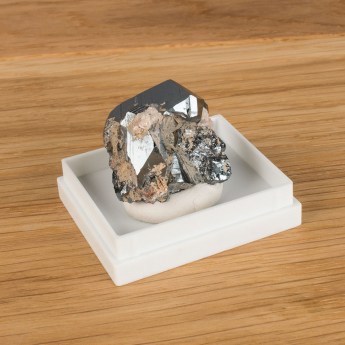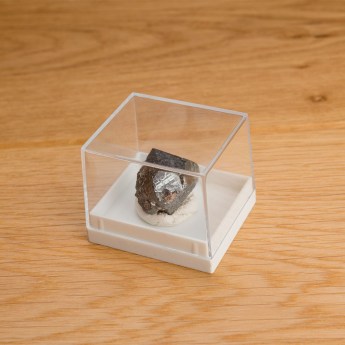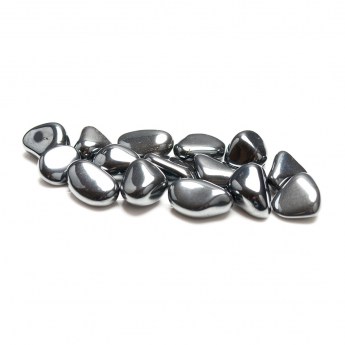Hematite: Properties, Facts and Photos

| Contents 1. What is Hematite? 2. The Meaning of Hematite 3. Component of Red Ochre 4. Hematite Crystal Meaning 5. Article Pictures 6. Shop Hematite |
What is Hematite?
Hematite (also spelt 'haematite' ) is a major source of iron and one of the main forms of iron oxide, with the other being magnetite.
Hematite is 70% iron, 30% oxygen. Its chemical composition is two iron atoms and three oxygen atoms.
Hematite, which often occurs with other iron minerals such as goethite and magnetite, is abundant worldwide. Vast amounts are found in a type of rock called a banded iron formation.
Hematite is widely used in the steel industry because, as an ore of iron, it can be fed straight into a blast furnace. A blast furnace converts iron oxides into liquid iron.
Due to its density, hematite is heavy. Although much harder than pure iron, it's also brittle. On the Mohs scale of hardness it grades 5.5 to 6.5.
Hematite can block an X-ray, so can be used to protect against radiation, specifically in medical and scientific environments.
Its colour ranges from black to silver grey, brown to reddish-brown and can also be red.
When used as a gemstone, it tends to be cut as a cabochon. Small faceted stones, although rare, can resemble black diamonds.
Hematite has the same crystal structure as the mineral corundum. Well-formed crystals are rare.
Hematite has a blood-red to reddish-brown streak. Streak describes the colour of a mineral in powdered form. Only after being broken and exposed to air do the edges turn red and powdery.
When heated, hematite can become magnetic, but it's quite weak.
Grains of hematite have been found on Mars. The planet's red colour is caused by fine grains blowing around during dust storms. The coarse grains, which are grey hematite, indicate that water may once have been present. Their formation may also be the result of volcanic activity.

The Meaning of Hematite
The meaning of hematite originates from the Greek word 'haema', which means 'blood'. This is because of its red-coloured streak.
Throughout history, this meaning has led to hematite's widespread use for blood disorders. Stones have also been worn to protect the wearer from bleeding.
The prefix 'haema' is present in the word 'haemoglobin', which is the protein that carries oxygen around the blood. It's also the prefix in 'haematoma', a solid swelling of clotted blood, and 'haematology', which is the study and treatment of the blood.
The ancient Greek philosopher Theophrastus describes 'haematites' as having the colour of 'dried blood'. The Roman author and naturalist Pliny the Elder also refers to haematite and says its colour is 'blood red'.
Pliny also talks about a 'precious stone' called 'haematites', but historians believe it's likely to be red jasper.
Main Component of Red Ochre
Red ochre, one of the oldest pigments on the planet, is made up primarily of hematite. It has been identified in cave paintings known to be at least 40,000 years old. Red ochre is believed to be one of the earliest powders that originates from a natural mineral.
Traces of hematite have been found on skeletal remains that date back 12,000 years to the Neolithic Age. More recently, it has been widely used by Native American Indians. Hematite was also popular during the New Age movement of the 1970s and 80s.
Today, it's still widely used as a pigment and most of the red colours around us are composed, to some degree, of hematite.

Hematite Crystal Meaning
Hematite is a stone of power that shields and protects. It deflects negative energy and creates a barrier that protects against hurtful words and behaviour.
It improves emotional resilience and assists with coping with stress, trauma and emotional challenges.
Hematite improves communication skills, enabling you to express feelings and emotions more effectively.
It helps you look at situations objectively, enabling you to see the bigger picture. It aids problem-solving and can help establish the facts when dealing with conflict.
Hematite enhances natural leadership abilities and inspires others to follow your lead. It amplifies inner strength, resolve and willpower and provides a boost of motivation to enable you to achieve goals and overcome obstacles.
Hematite is particularly beneficial for those studying mathematics or other subjects of a technical nature.
When used for meditation, it promotes a deep state of calmness and helps block out unwanted distractions.
It improves concentration, boosts memory, clears mental fog, and dissolves negativity. If you're easily distracted, hematite will help block unnecessary thoughts so you can remain focused.
In a new relationship, hematite can prevent things from progressing too quickly and will give you the strength to move on should things not work out.

Article Pictures
Pictures in our article are clickable and redirect to the original image.
The hematite in the first photo is on display in the Smithsonian National Museum of Natural History, Washington D.C.
The second photo is courtesy of Arturo R Montesinos.
The hematite in the third photo is housed in the Harvard Museum of Natural History, Massachusetts.
The last photo is courtesy of Stan Celestian.
Photos 1 and 3 were taken by Stone Mania.
Pop-up photos: Magnetite (in granitic matrix) - Courtesy of Stan Celestian. Red Jasper - Courtesy of James St. John.














